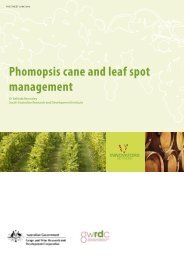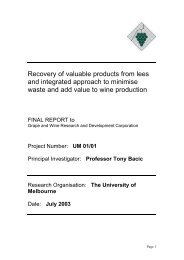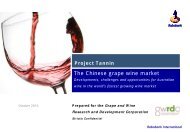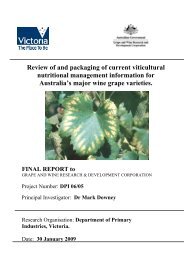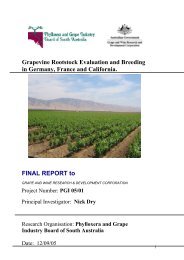Identification of the major drivers of 'phenolic' taste in ... - GWRDC
Identification of the major drivers of 'phenolic' taste in ... - GWRDC
Identification of the major drivers of 'phenolic' taste in ... - GWRDC
Create successful ePaper yourself
Turn your PDF publications into a flip-book with our unique Google optimized e-Paper software.
AWRI: <strong>Identification</strong> Of The Major Drivers Of ‘Phenolic’ Taste In White W<strong>in</strong>es<br />
<strong>of</strong> <strong>the</strong> mobile and stationary phase and <strong>in</strong>jected. The system was run at 800 rpm, 2 mL/m<strong>in</strong> flow rate<br />
with <strong>the</strong> aqueous layer as <strong>the</strong> mobile phase for 250 m<strong>in</strong>utes, dur<strong>in</strong>g which <strong>the</strong> early-elut<strong>in</strong>g GRP<br />
fraction was collected and reta<strong>in</strong>ed. The stationary phase was recovered and dried under vacuum at<br />
30°C to recover <strong>the</strong> rema<strong>in</strong><strong>in</strong>g phenolics. These were re-dissolved <strong>in</strong> 20 mL <strong>of</strong> a mixture <strong>of</strong> mobile<br />
and stationary phase <strong>of</strong> <strong>the</strong> HEMBWAT (3:7:3:0:7) system. The sample was <strong>in</strong>jected and fractionated<br />
under <strong>the</strong> same conditions as <strong>the</strong> previous step for 120 m<strong>in</strong>utes, whereby a fraction conta<strong>in</strong><strong>in</strong>g caftaric<br />
acid was obta<strong>in</strong>ed. The phenolic identity <strong>of</strong> <strong>the</strong> fractions were assessed by HPLC us<strong>in</strong>g <strong>the</strong> method<br />
described <strong>in</strong> Appendix A.3 before be<strong>in</strong>g dried under vacuum, freeze dried and stored at<br />
-80°C. The presence <strong>of</strong> macromolecules such as prote<strong>in</strong>s and polysaccharides were assessed us<strong>in</strong>g<br />
size exclusion chromatography (Phenomenex Biosep Sec-S-2000 column, 1 mL/m<strong>in</strong> NaNO3, 40°C, 5<br />
mg/mL, 25L <strong>in</strong>jection).<br />
7.2.2 Preparation <strong>of</strong> Sensory Samples<br />
A comparison <strong>of</strong> <strong>the</strong> reported ext<strong>in</strong>ction coefficient <strong>of</strong> GRP (Cheynier et al. 1986) with that <strong>of</strong> <strong>the</strong><br />
GRP isolate suggested <strong>the</strong> presence <strong>of</strong> impurities. Size exclusion chromatography showed that <strong>the</strong>y<br />
were not phenolic (as <strong>the</strong>y did not absorb at 280nm), be<strong>in</strong>g less than 1Kda <strong>in</strong> molecular weight were<br />
far too small to be ei<strong>the</strong>r polysaccharides or prote<strong>in</strong>s (compounds that have <strong>the</strong> potential to affect<br />
texture (Jones et al. 2008)). The retention time <strong>of</strong> <strong>the</strong> <strong>major</strong> impurity co<strong>in</strong>cided with that <strong>of</strong> potassium<br />
hydrogen tartrate, a ubiquitous w<strong>in</strong>e compound not known to contribute to ei<strong>the</strong>r <strong>the</strong> phenolic <strong>taste</strong> or<br />
texture <strong>of</strong> w<strong>in</strong>e.<br />
The caftaric and GRP isolates were added to <strong>the</strong> model w<strong>in</strong>e (10% v/v ethanol, pH 3.5) on <strong>the</strong> basis <strong>of</strong><br />
<strong>the</strong>ir reported ext<strong>in</strong>ction coefficients to 30 and 60 mg/L. These levels were selected after a review <strong>of</strong><br />
<strong>the</strong> literature and follow<strong>in</strong>g a tast<strong>in</strong>g by an experienced <strong>taste</strong> panel. The tast<strong>in</strong>g samples were prepared<br />
two hours prior to tast<strong>in</strong>g.<br />
7.2.3 Sensory Assessment<br />
Tasters<br />
Fourteen <strong>taste</strong>rs (eight females and six females) were tra<strong>in</strong>ed for this study. All had previous<br />
experience <strong>in</strong> <strong>the</strong> texture pr<strong>of</strong>il<strong>in</strong>g <strong>of</strong> white w<strong>in</strong>es, and most had previously evaluated <strong>the</strong> <strong>in</strong>-mouth<br />
texture <strong>of</strong> phenolic fractions extracted from white w<strong>in</strong>es.<br />
Taster Tra<strong>in</strong><strong>in</strong>g<br />
Taster tra<strong>in</strong><strong>in</strong>g was conducted over six sessions. Four commercial w<strong>in</strong>es are presented <strong>in</strong> <strong>the</strong> first<br />
session. These were a Verdiccio from Marche, Italy, a McLaren Vale Fiano, a P<strong>in</strong>ot Grigio from East<br />
Gippsland Victoria, and a Gewuztram<strong>in</strong>er from Alsace, France. These w<strong>in</strong>es were selected by an<br />
experienced white w<strong>in</strong>e tast<strong>in</strong>g panel to represent examples <strong>of</strong> bitterness, oil<strong>in</strong>ess, astr<strong>in</strong>gency and<br />
hotness.<br />
A‘phenolic hotness’ standard was needed. A workshop on white w<strong>in</strong>e phenolics was conducted at <strong>the</strong><br />
13 th Australian W<strong>in</strong>e Industry Technical Conference. Some participants identified a character that<br />
56




